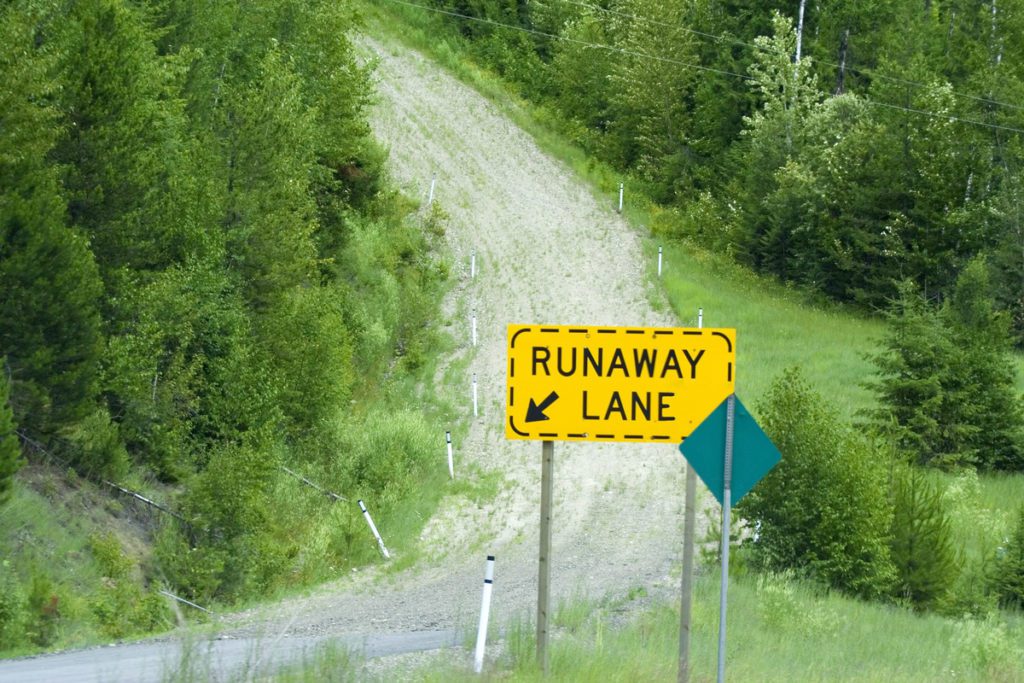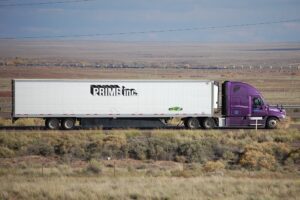Steep grades. Rapidly changing weather. Surprising curves. Mountain driving can be dangerous for a professional truck driver, especially if you’ve never encountered steep grades before.
Whether traveling through Colorado or West Pennsylvania, you need to know how to maintain safe speeds as you drive up and down steep mountain roads.
Going too fast down a grade could spell disaster. Less than ideal mountain road conditions can make matters worse. Reduce your risk of jackknifing your trailer, running off the road or getting into an accident with these mountain driving tips.
Always remember to follow the guidelines for mountain driving in your CDL manual. If you don’t have experience driving in the mountains, read through the mountain driving section of the CDL manual again and reach out to your fleet manager for more information.
Before You Head out
Do you have everything you need for the days ahead? Do you know what your route looks like? You should always review and plan your route before you take off. Check the weather forecast for the area you’re headed. Weather at higher altitudes changes quickly, so you must prepare for ice and snow and carry tire chains.
1. Check Your Service Brakes
Before every haul, you’re required to inspect your truck. If you’re heading into the mountains, pay special attention to your service brakes and air tanks.
Pads or shoes rub against drum and disc brakes to slow your speed. Friction from braking produces heat. When descending high elevations, all of your brakes need to be in working order. If a few brakes get out of adjustment, the remaining brakes have to work even harder to slow the vehicle, often causing them to overheat.
Excessive heat damages brake linings and reduces friction, which leads to brake fade. When brake fade happens, your brakes stop working effectively and render you unable to slow down.
2. Fuel up Before Driving Into the Mountains
There won’t be many gas stations in the mountains. You could drive 100 miles without seeing a truck stop. Fill up before you drive into the mountains, so you’re prepared in case of emergencies. A full tank of gas means you’ll have heat and electricity if you get into an accident or need to stop.
3. Pack an Emergency Kit
Every truck driver needs a winter emergency kit, whether you’re driving through mountain peaks or flat grasslands. It’s best to prepare for anything. Your emergency kit should include extra food, water, flares, flashlights and batteries, warm clothes and tire chains. CB radios are great when traveling into areas without good cell service.
Tips for Speed on Hills and Mountains
The best tip for driving in the mountains is to go slow and steady. There’s a saying in the trucking industry that goes, “You can drive down a mountain slowly one hundred times, but you can only drive fast down a mountain once.”
Gravity is a huge factor when climbing or descending a grade. Heavy loads combined with steep grades either slow your speed going up a hill or increase your speed going down one. Stick to lower gears when driving down a mountain road.

Tip #1: Start Off Slow
Many drivers don’t start down steep grades slowly enough. Even experienced drivers may go 20 mph above what’s considered a safe speed for the descent. Grades are posted under the speed limit on road signs. These signs give you an idea of what’s ahead and often have a maximum safe speed listed.
The following factors play into your safe speed:
- Weight of your vehicle
- Weight of your freight
- Grade length
- Grade steepness
- Weather
- Road conditions
Drivers shouldn’t assume that they’ll be able to slow down halfway down a hill. Don’t wait until it’s too late. Start at the proper speed for the grade at the top of the hill.
If you need to, turn on your hazard lights, so passing traffic knows you will move slowly. Don’t let other drivers pressure you into going faster than you’d like.
Tip #2: Rely on Your Engine Brake
Use your engine brake, or Jake brake, to control speed instead of applying your service brakes. Only using the service brakes to maintain speed could cause brake fade. Your service brakes are supplemental; you want to save them for slowing down and stopping with traffic.
Engine brakes have three positions. Brake positions 1 and 2 are better for less steep grades or portions of the hill, while position 3 is best for steeper grades. If your truck slows down too much, put the engine brake in position 1 or 2 instead of upshifting gears.
Bad weather may require you to drive even slower and manually maintain your speed. Using your engine brake and cruise control is not recommended on icy or snow-covered roads.

Tip #3: How to Maintain Speed During the Descent
As you descend a hill, your goal is to maintain a safe speed without using the service brakes. Heavy reliance on the service brakes could cause them to overheat and fade. Overheated brakes can also catch fire. Drivers should aim to descend at a speed that lets them use the engine brake alone.
Before heading down the grade, shift the transmission into a low gear. Don’t wait to shift gears until you’re already down the hill. Depending on the road’s steepness, you’ll want to descend in a gear that lets you stay between 1,800 and 2,000 rpms while maintaining your safe speed.
For Automated Transmissions & Good Weather Conditions
If you drive equipment with an automated transmission, you’ve probably heard of “Descent Mode” or “Descent Control.” On a dry road, “Descent Mode” maintains your speed. It uses your engine brake to keep your truck at the speed you desire.
How to Descend a Steep Grade:
- Ensure your cruise control and Jake brake is off.
- At the top of the hill, turn your Jake brakes on (start with 2) and set your cruise control to your safe speed.
- Begin your descent. Together, your engine and transmission will maintain the speed as you move down the mountain.
If you must use your service brakes, apply steady pressure intermittently to slow down. Don’t slam your brakes or leave your foot on the pedal. You’ll have to resume cruise control if you apply the service brakes.
For Manual Transmissions & Bad Weather Conditions
When road conditions are dicey, it’s time to revert to maintaining speed manually. Cruise control and the engine brake are not recommended for icy, snowy or wet roads. You could quickly lose control of the truck. In bad weather, your service brakes are your friends. Just be gentle with them.
Weigh the risk of operating during inclement weather. If the situation could be better in 10 hours, consider shutting down and waiting for the storm system to pass. This will allow time for plows to clear the roads and apply treatment.
According to the Federal Motor Carrier Safety Administration (FMCSA), brake problems and driving too fast for conditions are two of the top factors cited in large truck crashes. You want to start your descent at a slow speed—slower than you’d go in ideal conditions. Try maintaining speeds below 25 mph to keep control and prevent the service brakes from overheating.
When applying the service brakes, do so with easy, light pressure. Heavy pressure could put too much strain on the brakes. The proper way to descend a hill with your service brakes is called snub braking or the 5-3 technique.
What’s Snub Braking?
Snub braking helps you maintain speed without killing your service brakes. Here’s how to do it:
- Determine what your controlled speed is. What speed do you need to stay under or maintain?
- Apply the service brakes for about three seconds when you hit that speed.
- Use gentle pressure on the brake pedal—just enough to feel the truck slow.
- Release the brake when your speed is 5 to 6 mph below your controlled speed. (This usually takes about three seconds.)
- Continue this pattern as you descend the hill.
Let’s say your safe speed is 30 mph. When you hit 30 mph, gently apply the service brakes to reduce your speed to 25 mph. Then release the brakes. Repeat this technique the rest of the way.
Tip #4: Don’t Tailgate
Space is even more important as a driver descends a steep hill. You should leave as much room as possible between you and the vehicles ahead. Others may slip off the road, jackknife or cause an accident in bad weather. Animals may get in the road, or you may encounter a rockslide. More space gives you more time to slow down in case of a problem ahead.

Tip #5: Use the Runaway Ramp (if Needed)
Many steep mountain grades include runaway ramps or escape lanes. These ramps help runaway vehicles come to a stop safely away from other traffic. Often, ramps use loose gravel or soft sand. Some include uphill grades to help slow large vehicles.
Escape lanes are designed to get deeper and produce more resistance gradually. The farther you travel down a runaway ramp, the more resistance you meet. There’s no ticket or fine for using a runaway ramp; however, you will need to be towed out of it.
Escape lanes help save lives and freight. If you feel yourself losing control, always take the escape lane.
Driving in the mountains is breathtaking and exciting, but it is also risky. Make sure you understand proper protocol and techniques for handling steep grades before you hit the road.
Are you ready to take on the mountainside?
Sign up for Prime’s Driver Training Program to learn from experienced trainers and prepare to earn your Class A CDL. If you’re a professional driver already, we’d love to have you join Prime’s proud fleet.
Apply today to get started. Contact our Recruiting Department at 866-290-1568 for information about our Driver Training Program and available truck driving jobs.


